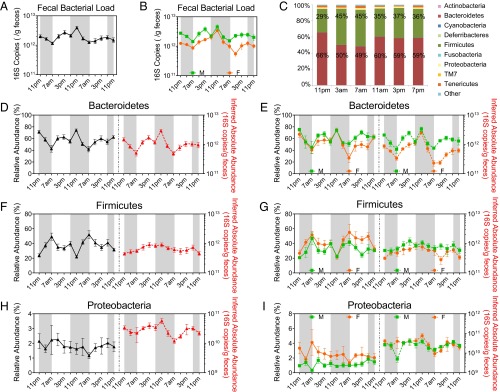Fig. 1.

Diurnal oscillation of intestinal microbiota composition in C57BL/6 mice. (A and B) Fecal bacterial load oscillates diurnally in mice both when combined (A) and separated by sex (B), as indicated by 16S rRNA copy numbers normalized to sample weight. JTK_ CYCLE revealed P = 0.00012 for mice of combined genders, P = 0.032 for male mice, and P = 2.8E-06 for female mice. (C) Bar graphs of average relative abundances of bacterial phyla in fecal microbial communities of combined genders at different time-of-day. Bacteroidetes (red) and Firmicutes (green) proportions are labeled. (D–I) The relative abundance (left y axis) and inferred absolute abundance (right y axis) of Bacteroidetes of combined genders (D, pr = 0.00012 and pa = 1.7E-06), male and female sex (E, pr = 0.025 and pa = 0.0029 for male mice; pr = 0.0006 and pa = 9.5E-10 for female mice); Firmicutes of combined genders (F, pr = 6.3E-05 and pa = 1), male and female sex (G, pr= 0.049 and pa = 1 for male mice; pr = 0.0011 and pa = 1 for female mice); and Proteobacteria of combined genders (H, pr = 1 and pa = 0.00065), male and female sex (I, pr= 0.69 and pa= 0.0047 for male mice; pr = 1 and pa = 0.13 for female mice). Nmale = 7, Nfemale = 7. M, male; F, female. r, relative abundance; a, inferred absolute abundance. The dark phase is indicated by gray shading.
